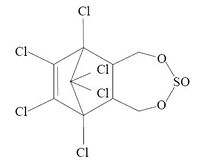Difference between revisions of "Endosulfan"
m () |
Dronkers J (talk | contribs) |
||
| (11 intermediate revisions by 2 users not shown) | |||
| Line 1: | Line 1: | ||
| − | + | {{tocright}} | |
{{Definition|title=endosulfan | {{Definition|title=endosulfan | ||
| Line 8: | Line 8: | ||
{| class="toccolours" border="1" style="float: right; clear: right; margin: 0 0 1em 1em; border-collapse: collapse;" | {| class="toccolours" border="1" style="float: right; clear: right; margin: 0 0 1em 1em; border-collapse: collapse;" | ||
| − | ! bgcolor="#FF8888" | | + | ! bgcolor="#FF8888" | Endosulfan |
|- | |- | ||
| align="center" bgcolor="#FFFFFF" | [[Image:endosulphan.jpg|200px|endosulphan]] | | align="center" bgcolor="#FFFFFF" | [[Image:endosulphan.jpg|200px|endosulphan]] | ||
| Line 18: | Line 18: | ||
|} | |} | ||
| − | + | Endosulfan is used as a insecticide on a wide variety of insects and mites, predominantly in temperate, subtropic | |
and tropic climatic zones. In Europe it has been used for more than 40 years. Currently it is used at 340 tonnes per year, mainly in Spain but also in Belgium, France, Portugal and Switzerland. | and tropic climatic zones. In Europe it has been used for more than 40 years. Currently it is used at 340 tonnes per year, mainly in Spain but also in Belgium, France, Portugal and Switzerland. | ||
| − | + | Endosulfan enters rivers by run-off from treated areas. The rivers transport it to the sea. It can also enter the ocean through atmospheric transport<ref name = OECD>[http://www.ospar.org/documents%5Cdbase%5Cpublications%5Cp00149_Background%20document%20on%20Endosulphan.pdf OSPAR Commission, 2004: OSPAR background document on endosulphan]</ref>. | |
| − | + | Endosulfan is moderately [[persistent]] in water. It's main metabolite is endosulfan sulfate which is more stable and equally [[toxic]]. In the soil endosulfan and endosulfan sulphate are highly persistent substances with a [[half-life]] for endosulphan sulphate of 120 days. | |
| − | + | Endosulfan is highly [[bioaccumulation|bioaccumulative]] and is expected to [[biomagnification|biomagnify]]. | |
| − | At constant exposure it is very toxic to all organisms. Concentrations of 1 mg/l are toxic | + | At constant exposure it is very toxic to all organisms. Concentrations of 1 mg/l are toxic to all marine organisms, while concentrations of only 0,04 µg/l are already toxic for crustaceans. In rats doses above 18 mg per kg body weight can prove lethal. |
| − | + | Endosulfan and endosulfan sulfate are potentially [[endocrine disrupting compounds]]: in vivo tests with [[pollution and pelagic fishes|fish]] show that endosulphan induces changes on ovaries, developmental changes and has an impact on their behaviour. | |
| − | + | Endosulfan concentrations of 0,06 μg/l have been found in water and of 81,6 μg/kg in the sediment. These are levels which can cause harm to organisms<ref name = OECD>[http://www.ospar.org/documents%5Cdbase%5Cpublications%5Cp00149_Background%20document%20on%20Endosulphan.pdf OSPAR Commission, 2004: OSPAR background document on endosulfan]</ref>. | |
<P> | <P> | ||
<BR> | <BR> | ||
| Line 50: | Line 50: | ||
==References== | ==References== | ||
<references/> | <references/> | ||
| + | {{author | ||
| + | |AuthorID=19826 | ||
| + | |AuthorFullName=Daphnis De Pooter | ||
| + | |AuthorName=Daphnisd}} | ||
| − | [[Category: | + | [[Category:Toxicity chemicals]] |
Latest revision as of 13:13, 9 August 2020
Definition of endosulfan:
Endosulfan is a synthetic pesticide which belongs to the group of organochlorine compounds with a sulfite group[1].
This is the common definition for endosulfan, other definitions can be discussed in the article
|
Notes
| Endosulfan |
|---|

|
| Formula |
| C9H6Cl6O3S |
Endosulfan is used as a insecticide on a wide variety of insects and mites, predominantly in temperate, subtropic and tropic climatic zones. In Europe it has been used for more than 40 years. Currently it is used at 340 tonnes per year, mainly in Spain but also in Belgium, France, Portugal and Switzerland. Endosulfan enters rivers by run-off from treated areas. The rivers transport it to the sea. It can also enter the ocean through atmospheric transport[1].
Endosulfan is moderately persistent in water. It's main metabolite is endosulfan sulfate which is more stable and equally toxic. In the soil endosulfan and endosulfan sulphate are highly persistent substances with a half-life for endosulphan sulphate of 120 days. Endosulfan is highly bioaccumulative and is expected to biomagnify. At constant exposure it is very toxic to all organisms. Concentrations of 1 mg/l are toxic to all marine organisms, while concentrations of only 0,04 µg/l are already toxic for crustaceans. In rats doses above 18 mg per kg body weight can prove lethal. Endosulfan and endosulfan sulfate are potentially endocrine disrupting compounds: in vivo tests with fish show that endosulphan induces changes on ovaries, developmental changes and has an impact on their behaviour.
Endosulfan concentrations of 0,06 μg/l have been found in water and of 81,6 μg/kg in the sediment. These are levels which can cause harm to organisms[1].
Environmental standards and legislation
Included in the OSPAR list of substances of priority action
Included in the water framework list of priority substances
See also
OSPAR background document on endosulphan
References
- ↑ 1.0 1.1 1.2 OSPAR Commission, 2004: OSPAR background document on endosulfan Cite error: Invalid
<ref>tag; name "OECD" defined multiple times with different content Cite error: Invalid<ref>tag; name "OECD" defined multiple times with different content
Please note that others may also have edited the contents of this article.
|